For I desire mercy, and not sacrifice, and the knowledge of God rather than burnt-offerings. – Hosea 6:6
The act of milking is about as intimate as a fellow can get to a goat without suckling from the teat itself, a practice still taboo on the farm. Milking Angie – one of the resident goats on the organic farm at Adamah, a three month fellowship that integrates sustainable farming, Jewish learning, and spiritual practice at Isabella Freedman in Western Connecticut – requires more dexterity, coordination, and finesse than one might expect. Each fellow takes a turn at goat milking as part of daily chores, and I have been surprised by the development of a distinctive bulging hand muscle between my thumb and forefinger as a result of handling the moody temperament of this domesticated farm animal. The bulge marks much well-intentioned squeezing on cold winter mornings, icicles hanging from my own goatee as I empty Angie's udders of sweet milk. And in truth, it pays to abstain from quaffing the raw milk directly from Angie herself, as the eventual self-expression of the bacteria within yields yogurt, farmer’s cheese, and chèvre – just a few of the staples we have learned to bring forth from the ever-flowing goat sap at our hands.
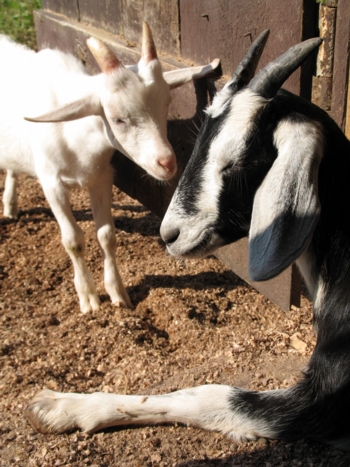 Lady goats are royalty in Adamah's humble kingdom of animal husbandry. They always receive the finest kitchen compost scraps; and with names like Zilpah, Ness, and Omer, they hint at biblical presence even when feasting on brussel sprouts in the barn. But call these animals what you will. Despite their regal generous offering of sustenance, the true articulation of compassion and respect for them is allowing for full expression of their goaty-ness – musky aroma, butting horns, split-hoofed stomping, and nomadic foraging. Simply raising a goat to live and engender life-juice can be a practice of restorative justice. And with each bite of hand-crafted goat ice cream, justice tastes ever so sweet.
Lady goats are royalty in Adamah's humble kingdom of animal husbandry. They always receive the finest kitchen compost scraps; and with names like Zilpah, Ness, and Omer, they hint at biblical presence even when feasting on brussel sprouts in the barn. But call these animals what you will. Despite their regal generous offering of sustenance, the true articulation of compassion and respect for them is allowing for full expression of their goaty-ness – musky aroma, butting horns, split-hoofed stomping, and nomadic foraging. Simply raising a goat to live and engender life-juice can be a practice of restorative justice. And with each bite of hand-crafted goat ice cream, justice tastes ever so sweet.
An Invitation from the Chubby Bunny One morning word spread throughout the pasture that the neighboring Chubby Bunny Organic Farm had invited us to participate in their yearly slaughter of the lambs. Snapping out of an Edenic haze, I released Angie’s twin teats and jumped at the offer. Although morning milking had come to be meditative and earth-centering for me, I knew it could never invigorate me like the questions, suspense, and excitement of witnessing a slaughter. My sheltered existence as a goat-milker begged to be challenged by facing the ultimate act of human intervention into the life and death cycle of animals. And as a Jewish farmer adhering to an eco-kosher vegetarian diet, this was the perfect moment to put the central Judaic imperative of tsa’ar ba’alei chaim (prevention of cruelty to animals) to the test. 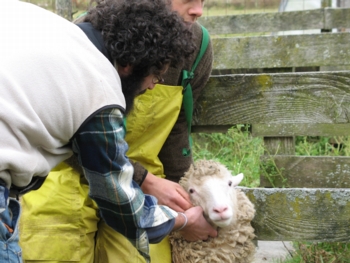 I was also intruiged by the philosophical underpinnings of modern-day slaughterers like the one I would meet at Chubby Bunny. He stressed the importance of personally offering deep gratitude to the lamb and of limiting its suffering through a swift, precise cut. Each part of the lamb was destined for human use from the outset – outer fleece to innermost entrails. And since the process would not be guided by shechita, any difficulties I anticipated with the stance on slaughter in Jewish law could be left at the barn door. I wanted to arrive as an eyewitness, pure and simple, and to behold the respectful killing of a lamb. Walking through the farm with no sense of judgment, opening my heart to learn from the lamb and the slaughterer both, I sought a teaching about life and death.
I was also intruiged by the philosophical underpinnings of modern-day slaughterers like the one I would meet at Chubby Bunny. He stressed the importance of personally offering deep gratitude to the lamb and of limiting its suffering through a swift, precise cut. Each part of the lamb was destined for human use from the outset – outer fleece to innermost entrails. And since the process would not be guided by shechita, any difficulties I anticipated with the stance on slaughter in Jewish law could be left at the barn door. I wanted to arrive as an eyewitness, pure and simple, and to behold the respectful killing of a lamb. Walking through the farm with no sense of judgment, opening my heart to learn from the lamb and the slaughterer both, I sought a teaching about life and death.
The Sacrificial Lamb Each member of the fellowship that had decided to take part in the slaughter disembarked from our biodiesel flatbed truck with a slightly different intention. Leviathan, the most spiritually-inclined member of the group, was interested in the transmutation of the lamb’s soul. He wanted to bear witness to the rejoining of the animal’s essence with Hashem, a venerable rising of the holy spark of life back to its source. He advised us all to take heed in the moment of death, cognizant of when the animal's soul rejoined the oversoul.
Yoshi, on the other hand, was there to get down and dirty with the brusque physicality of slaughtering. An avid meat-eater with an ethical bent, his interest focused on taking ownership and responsibility for the killing, From the very start, Yoshi had volunteered enthusiastically to participate in each necessary function of the act – jumping at the chance to hold down the lamb in order to ensure a clean cut of the neck, sawing off of the lamb's head from its limply hanging body, and assisting in the final packaging of the loin chops. 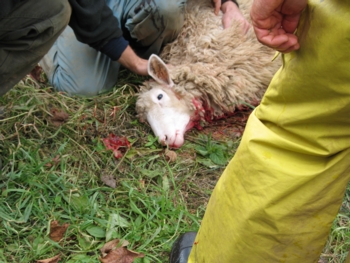 Not everyone was so gung-ho about the operation. Rivka had been a last minute addition to our crew, tentatively climbing into the truck, her eyes dark and heavy with the burden of moral duty. As a long time vegetarian and animal rights activist she must have been coming along, if nothing else, just to make damn sure that no one would delight in the affair. Rivka could not disguise her disgust, the muscles of her face distorting with each and every slice of the carcass. Yet even Rivka's principled high ground cracked as the voyeuristic pleasure of beholding the horrific killing and its calculated aftermath. By nightfall, Rivka had checked herself into the emergency room with abdominal pains that would last for weeks – Leviathan keenly pointing out that perhaps she had embodied the pain of the lamb and taken on the tortured qualities of its soul.
Not everyone was so gung-ho about the operation. Rivka had been a last minute addition to our crew, tentatively climbing into the truck, her eyes dark and heavy with the burden of moral duty. As a long time vegetarian and animal rights activist she must have been coming along, if nothing else, just to make damn sure that no one would delight in the affair. Rivka could not disguise her disgust, the muscles of her face distorting with each and every slice of the carcass. Yet even Rivka's principled high ground cracked as the voyeuristic pleasure of beholding the horrific killing and its calculated aftermath. By nightfall, Rivka had checked herself into the emergency room with abdominal pains that would last for weeks – Leviathan keenly pointing out that perhaps she had embodied the pain of the lamb and taken on the tortured qualities of its soul.
The rest of our group held neutral ground, more or less taking on the roles of silent witnesses, particularly as we entered the processing stage. As the lamb was divided into choice cuts of meat and packaged for freezing, the Chubby Bunny butcher offered an informal autopsy report, inconspicuously passing around various organs, providing everyone with a first hand feel and view of the insides of the lamb, its anatomy naked before our eyes. The long, dreary dissection of the carcass did lead to its own form of barnyard absurdity as Moyra conflated the spleen she was holding to a pancake. But despite a few puerile pauses, the slaughter proceeded respectfully and professionally with precision and care.
====
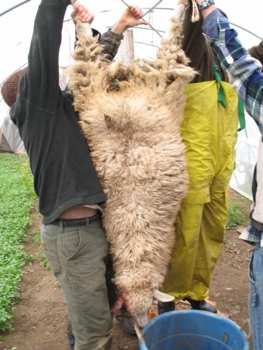 As the slicing and sawing came to a close, more and more of the lamb was neatly wrapped in white freezer paper and labeled appropriately: primal roast, short loin, valentine chop, riblet, crown roast, cutlet. With its life-blood let, the lamb was now meat. The best cuts had already been pre-ordered by family, friends, and members of the local CSA (Community Supported Agriculture), so the meat would not have to travel very far. In fact, the entire process – slaughtering, cutting, and transporting – had intentionally and conscientiously required very minimal energy costs or automated practices.
As the slicing and sawing came to a close, more and more of the lamb was neatly wrapped in white freezer paper and labeled appropriately: primal roast, short loin, valentine chop, riblet, crown roast, cutlet. With its life-blood let, the lamb was now meat. The best cuts had already been pre-ordered by family, friends, and members of the local CSA (Community Supported Agriculture), so the meat would not have to travel very far. In fact, the entire process – slaughtering, cutting, and transporting – had intentionally and conscientiously required very minimal energy costs or automated practices.
The slaughterer's diligent care for respecting the animal, fullest use of available resources, and the invitation for witnessing the act itself all felt right. But as I exited the farm gates of the Chubby Bunny with my fellow eco-Jewish farmers, post-slaughter contemplativeness syndrome set in.
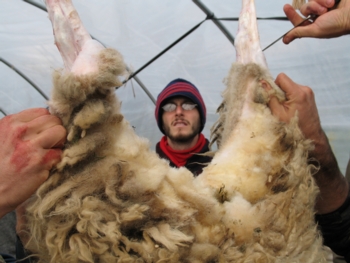 Back to the Sources In considering the passage in Job 19:26 "From my flesh I see God," the Ba'al Shem Tov – the founder of Hasidism – teaches that "from the physical we can perceive the spiritual.” Riding back to the pasture to attend to Angie, I wondered about the Jewish spiritual import of the slaughter I had just witnessed.
Back to the Sources In considering the passage in Job 19:26 "From my flesh I see God," the Ba'al Shem Tov – the founder of Hasidism – teaches that "from the physical we can perceive the spiritual.” Riding back to the pasture to attend to Angie, I wondered about the Jewish spiritual import of the slaughter I had just witnessed.
Consider for a moment the biblical significance of the lamb as a symbol of meekness and the shepherd as the model of the selfless guardian of all things chaste. Long before David slay Goliath and was crowned King of Israel, he had demonstrated his bravery as a lowly shepherd, protecting his flock by fighting off wild animals. In Psalm 23, David likens the Lord to a shepherd, illustrating one of the most quintessential relationships between God and mankind. Jesus Christ, as Christianity's genetic and occupational descendant of David, is described as the peaceful warrior/shepherd par excellence. These days one would be hard-pressed to find Baby Jesus in a nativity scene without sheep.
Both Jewish and Christian mythologies offer the apocalyptic icon of the lamb as a harbinger of peace. In Isaiah’s prophetic vision of the messianic era, the wolf lies down with the lamb, signifying the end of predatory-prey relationships among all beings. This powerful image of a future time of peaceful relations also contains the idyllic longing for a return to the Garden of Eden. Soon after banishment of the first humans from the garden, the lamb becomes a target in the open killing season amongst the thorns and thistles of a cruel world.
Since this fall from grace from the herbaceous abundance of the Garden, our human ancestors have been forced to live off the fat and skinny of the land, roaming among the vicissitudes of the natural rhythms of life. In the biblical and a variety of later Jewish worldviews, people satisfied their lust for blood by feasting upon most any living being they could ensnare, while the Jewish people – knee-deep in their holy covenant with the Divine – were granted no such opportunities for wanton excess. The consumption of flesh was limited to meat prepared through ritualized slaughter upon the altar, taming the pangs of bloodthirsty humans.
Today, the remnants of the holy altar for slaughter have been transferred to the kitchen and dining room. At the Sabbath table, for instance, the challah, a term referring to the biblically commanded sacrificial portion given to priests, serves as a reminder and living link to the Temple period. Yet aside from the olive-sized bit of dough that is removed and burnt during halachic preparation, spiritualized burnt-offerings no longer exist. In their place we find many other outlets, most notably, study, rites of prayer, and all variety of jurisdictions in the Jewish legal system, including kashrut. By extending a complex litany of prohibitions pertaining to the slaughter and consumption of meat, the Rabbis guarded against the unfettered expression of human animalistic desires, tying it directly to service to God: "Elazar ben Azariah taught, 'Don’t say ‘I have no desire to eat pig’s flesh,’ but rather say, ‘I would like to eat it, but what can I do seeing that my Father in heaven has decreed against it?’” (Sifra, K’doshim, 11:22)
Angie, Where Will You Lead Us from Here? Fast-forward to present day kosher slaughterhouses and see how far we have strayed from the tenuous balance of playing the roles of both guardian and holy butcher. Here, a sacred ritual is undone, flesh desecrated, and holy sparks smothered. In 2005, PETA released an undercover video documenting the brutal practices of AgriProcessors, the world’s largest glatt kosher slaughterhouse. 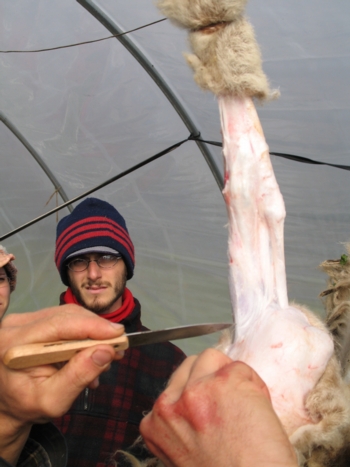 One of the many habitual practices the video revealed occurring at the plant in Postville, Iowa included ripping out the tracheas and esophagi from fully conscious cattle. This is but one glaring violation of the ethical basis of kashrut and the basic Jewish understanding of how to treat animals with compassion. Today’s mechanized extraction of marketplace bound flesh rejects the sacralization of life. The forward march of efficiency renders the spirit spineless, reducing the body of the lamb to a lump of flesh marked as a commodity on a spreadsheet. As humankind's unbridled desire to consume meat and its commodified fulfillment has spiraled out of control, we have engendered complete estrangement of the consumer from the life and death of the animal it devours.
One of the many habitual practices the video revealed occurring at the plant in Postville, Iowa included ripping out the tracheas and esophagi from fully conscious cattle. This is but one glaring violation of the ethical basis of kashrut and the basic Jewish understanding of how to treat animals with compassion. Today’s mechanized extraction of marketplace bound flesh rejects the sacralization of life. The forward march of efficiency renders the spirit spineless, reducing the body of the lamb to a lump of flesh marked as a commodity on a spreadsheet. As humankind's unbridled desire to consume meat and its commodified fulfillment has spiraled out of control, we have engendered complete estrangement of the consumer from the life and death of the animal it devours.
Prophesy reveals that one day we will return to an Edenic vegetarian world where humankind beats swords into plowshares and once again subsists on an entirely green, life-affirming diet. Rav Kook teaches: “In messianic days the effect of knowledge will spread even to animals…and sacrifices in the Temple will consist of vegetation, and it will be pleasing to God as in days of old…” (Olat Rayah, Vol. 1, p. 292). In the meantime, humane slaughter like the kind I witnessed at Chubby Bunny still involves spurts of blood and many reservations. Whether on a factory or family farm, the gruesome realities of slaughter cannot be escaped. Yet taking personal responsibility for the slaughter, by hand and not by hook, allows a relationship of respect to be renewed – an opening, perhaps, to redeeming our humanity and the lamb’s animality at once. The manner in which we conduct ourselves in relation to animal life is but one considerable measure of our evolutionary progress. With humankind’s unique capacity to exercise both brutal dominion and compassionate stewardship on this earth, the tension between these competing instincts shepherds us forward. And whether we reach greener pastures, well, that is up to the shepherd.







